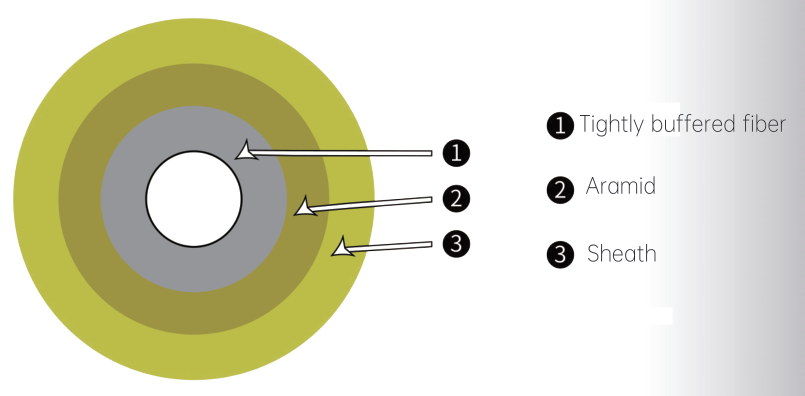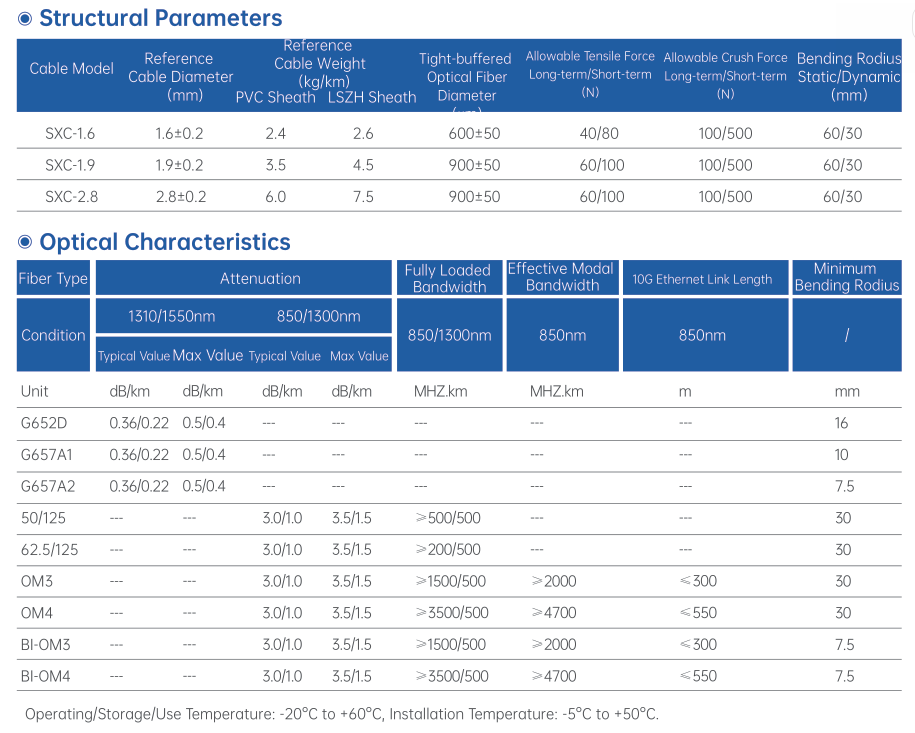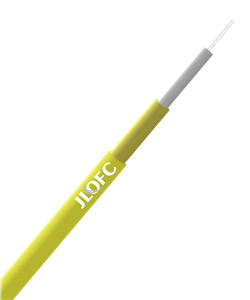In modern communication networks, optical cables, as key carriers for information transmission, their performance directly affects communication quality and efficiency. SXC optical cable, with its unique parameter characteristics, stands out among numerous optical cable products and is widely used in access networks and fiber-to-the-home scenarios, providing solid support for the development of the communication industry.
Product Description
The single core indoor fiber optic cable utilizes 900μm or 600μm tight-buffered optical fibers as the optical transmission unit, with aramid yarns serving as the strength member. The cable is then extruded with a layer of polyvinyl chloride(PVC)as the outer sheath.Alternatively, low-smoke zero-halogen(LSZH)materials can be
provided based on customer requirements.
Product Feature
◆The use of tight-buffered optical fibers facilitates easy stripping.
◆Tight-buffered optical fibers exhibit excellent flame retardancy.;
◆Aramid yarn strength members provide outstanding tensile performance for the cable.
◆The outer sheathmaterial offers corrosion resistance, waterproofing, flame resistance, and environmental friendliness.
Product Applications
• Fiber optic patch cords or pigtails for active connections.
• Indoor riser and plenum cabling for vertical shafts and forced ventilation.
• Interconnection of instruments and communication equipment.


Delivery Length
Recommended Length: 2000m; other lengths can be provided according to customer requirements.
I. Structural Parameter Characteristics
(I) Optical Transmission Medium
SXC optical cable uses a single Φ900μm or Φ600μm tight - buffered fiber as the core optical transmission medium. The tight - buffered fiber has a compact structure, which effectively isolates the fiber from the external environment and reduces the interference of external factors on optical signal transmission. This design enables the fiber to better maintain the stability of its optical performance during installation and use. Compared with loose - tube fibers, tight - buffered fibers do not require additional filling materials to prevent moisture intrusion, which reduces structural complexity. At the same time, they are easy to strip during construction, facilitating connection with various optical communication equipment and greatly improving construction efficiency.
(II) Stress - Reinforcing Unit
A layer of aramid material covering the outside constitutes the stress - reinforcing unit of the SXC optical cable. Aramid has the characteristics of high strength and low density. Its strength is several times that of steel wire, while its weight is much lower than that of steel wire. This characteristic enables the optical cable to ensure good tensile performance without significantly increasing its own weight, making it easy to lay in various environments. In practical applications, whether it is overhead laying, pipeline laying or indoor wiring, aramid reinforcing elements can effectively resist tensile force, ensuring that the internal fibers will not break due to stress when the optical cable is pulled by external forces, thus guaranteeing the stable transmission of optical signals. For example, during overhead laying, the optical cable needs to bear its own gravity and external forces such as wind force. Aramid reinforcing elements can give full play to their tensile advantages to prevent the optical cable from being damaged due to long - term stress.
(III) Sheath Material
The outermost extruded sheath material of SXC optical cable mainly has two choices: polyvinyl chloride (PVC) and low - smoke zero - halogen material (LSZH). PVC material has good flexibility, corrosion resistance and processing performance, and can provide basic protection for the optical cable. It can effectively resist the erosion of chemical substances in the general environment, prevent moisture from entering the interior of the optical cable, and protect the internal fibers and reinforcing elements. The LSZH material has more prominent environmental protection and safety performance. It does not produce a lot of smoke and toxic halogen gases when burned, which greatly reduces the harm to people and the environment in case of fire. At the same time, LSZH material also has good flame - retardant performance, which can effectively prevent the spread of fire and meet the strict fire safety requirements of modern buildings. In some places with high environmental and safety requirements, such as densely populated areas like hospitals, schools, shopping malls, and communication computer rooms with strict fire protection requirements, SXC optical cables with LSZH sheaths are widely used.
II. Optical Characteristic Parameter Characteristics
(I) Attenuation Characteristics
The attenuation characteristics of SXC optical cable are closely related to the type of fiber used. When using 50/125μm multimode fiber, at the wavelength of 850nm, the attenuation is generally ≤3.5dB/km; at the wavelength of 1300nm, the attenuation is ≤1.5dB/km. For 62.5/125μm multimode fiber, also at the wavelength of 850nm, the attenuation is ≤3.5dB/km; at the wavelength of 1300nm, the attenuation is ≤1.5dB/km. If G.652 single - mode fiber is used, at the wavelength of 1310nm, the attenuation is ≤0.45dB/km; at the wavelength of 1550nm, the attenuation is ≤0.30dB/km. For G.655 single - mode fiber, at the wavelength of 1310nm, the attenuation is ≤0.50dB/km; at the wavelength of 1550nm, the attenuation is ≤0.50dB/km. Lower attenuation means less energy loss when optical signals are transmitted in the optical cable, which can ensure the stable transmission of signals over a longer distance. For example, in fiber - to - the - home applications, the optical cable transmission from the optical distribution node in the community to the user's home may need to go through hundreds of meters or even thousands of meters. The low attenuation characteristic of SXC optical cable can ensure that the optical signal still has sufficient strength when it reaches the user end, meeting the user's demand for high - speed and stable network.
(II) Bandwidth Characteristics
The bandwidth characteristics of SXC optical cables with different types of fibers are also different. For SXC optical cable with 50/125μm multimode fiber, at the wavelength of 850nm, the bandwidth is ≥500MHz·km; at the wavelength of 1300nm, the bandwidth is ≥1000MHz·km. For SXC optical cable with 62.5/125μm multimode fiber, at the wavelength of 850nm, the bandwidth is ≥200MHz·km; at the wavelength of 1300nm, the bandwidth is ≥600MHz·km. A larger bandwidth enables the optical cable to transmit more information, meeting the demand for high - speed data transmission. With the rapid development of Internet technology, large - data applications such as high - definition video, online games, and cloud computing are becoming increasingly popular, and the demand for network bandwidth is getting higher and higher. The high - bandwidth characteristic of SXC optical cable enables it to easily cope with these application scenarios and provide users with a smooth network experience. For example, in enterprise campus networks, a large amount of data exchange and real - time communication require high - speed and stable network support. The high bandwidth of SXC optical cable can ensure efficient and smooth information transmission within the enterprise, improving the operation efficiency of the enterprise.
(III) Numerical Aperture
The numerical aperture of SXC optical cable with 50/125μm multimode fiber is 0.200±0.015NA, and that of SXC optical cable with 62.5/125μm multimode fiber is 0.275±0.015NA. Numerical aperture reflects the ability of a fiber to collect and transmit light. An appropriate numerical aperture can ensure that optical signals are effectively coupled into the fiber and transmitted stably in the fiber. At the optical transmitting end, the light emitted by the light source needs to be coupled into the fiber through a certain optical system. The numerical aperture determines the amount of optical power that can be coupled into the fiber. When the numerical aperture is large, the fiber can receive more optical signals, but at the same time, it may lead to an increase in intermodal dispersion, affecting the transmission distance and bandwidth. The numerical aperture of the fiber used in SXC optical cable is carefully designed to ensure sufficient optical coupling efficiency while minimizing the impact of intermodal dispersion, thus achieving good optical transmission performance.
(IV) Cable Cutoff Wavelength
For SXC optical cable using G.652 fiber, the cable cutoff wavelength is ≤1260nm; for SXC optical cable using G.655 fiber, the cable cutoff wavelength is ≤1480nm. The cable cutoff wavelength is an important optical parameter, which determines the shortest wavelength at which the fiber can work normally. When the wavelength of the optical signal is less than the cutoff wavelength, the fiber may have multimode transmission phenomenon, leading to an increase in intermodal dispersion and affecting the signal transmission quality. Above the cutoff wavelength, the fiber can transmit in single mode, which greatly reduces the impact of intermodal dispersion and ensures the high - quality transmission of optical signals. The cutoff wavelength parameter of SXC optical cable is reasonably designed to ensure that the fiber is always in single - mode transmission state within the commonly used communication wavelength range, providing a reliable guarantee for high - speed and long - distance optical communication.
III. Mechanical Performance Parameter Characteristics
(I) Tensile Strength
Aramid reinforcing elements endow SXC optical cable with excellent tensile performance. For example, when the diameter of the optical cable is 2.8±0.2mm, the short - term allowable tensile force is 150N; when the diameter of the optical cable is 2.0±0.2mm, the short - term allowable tensile force is 120N. During long - term use, the optical cable can also withstand a certain amount of tension without being damaged. This good tensile performance enables SXC optical cable to work stably in various laying methods. During overhead laying, the optical cable needs to bear its own gravity and external forces such as wind force. The high tensile strength of SXC optical cable can ensure that it remains intact under harsh weather conditions without affecting the transmission of optical signals. In pipeline laying, the optical cable may be subjected to tension during the traction process, and the tensile performance of SXC optical cable can also ensure that it will not be damaged due to excessive stress during laying.
(II) Compressive Strength
SXC optical cable also has certain performance indicators in terms of compression resistance. For example, when the diameter of the optical cable is within a certain range, the short - term allowable crushing force is 500N/100mm. This means that the optical cable can still ensure the normal operation of the internal fibers when subjected to a certain degree of external extrusion. In practical applications, the optical cable may be subjected to pressure from the surrounding environment, such as soil pressure and stone extrusion during direct burial laying. The compressive performance of SXC optical cable can effectively resist these external forces, preventing the fiber from being deformed or broken due to compression, thus ensuring the stable transmission of optical signals. In some complex environments such as underground comprehensive pipe corridors, the compressive performance of SXC optical cable enables it to adapt to the co - laying of multiple pipelines, avoiding the impact of extrusion from other pipelines on its own performance.
(III) Bending Radius
The bending radius of SXC optical cable is divided into static bending radius and dynamic bending radius. In general, the dynamic bending radius is required to be not less than 20 times the diameter of the optical cable. For example, for an optical cable with a diameter of 2.8mm, its dynamic bending radius should be not less than 56mm. The small bending radius requirement makes SXC optical cable have good flexibility and can be laid and installed in narrow spaces. In indoor wiring and other scenarios, it is often necessary to bend the optical cable around obstacles or along the corner of the wall. The small bending radius characteristic of SXC optical cable enables it to easily adapt to these complex wiring environments, improving the convenience and flexibility of construction. At the same time, good bending performance also helps to reduce the increase in fiber attenuation caused by bending, ensuring the stable transmission of optical signals in the bent state.
IV. Environmental Performance Parameter Characteristics
(I) Operating Temperature Range
SXC optical cable can usually work normally within the temperature range of -20℃ to +60℃. This wide operating temperature range enables it to adapt to the use requirements in different regions and environments. Whether in cold northern regions where the winter temperature may drop to more than ten degrees below zero or even lower, or in hot southern regions where the summer temperature often exceeds 30℃, SXC optical cable can maintain stable performance. In some industrial environments, equipment may generate a lot of heat during operation, leading to an increase in the surrounding environment temperature. SXC optical cable can also work normally in such high - temperature environments without performance degradation due to temperature changes, ensuring communication reliability.
(II) Waterproof Performance
Although SXC optical cable does not have extremely high waterproof requirements like some optical cables used in underwater or humid environments, it also has a certain waterproof capacity. Its tight - buffered fiber structure and the outer sheath material can prevent moisture intrusion to a certain extent. In general indoor environments or slightly humid environments, SXC optical cable can effectively prevent moisture from eroding the fiber and ensure the normal transmission of optical signals. Even in some outdoor overhead laying scenarios that may occasionally encounter rain, as long as it is not in a water - logged or heavy rain soaked environment for a long time, SXC optical cable can maintain a good working state by virtue of its own waterproof design, avoiding fiber attenuation increase or other faults caused by moisture intrusion.
(III) Flame - Retardant Performance
As mentioned earlier, the sheath materials of SXC optical cable, whether PVC or LSZH, have certain flame - retardant performance. Optical cables with LSZH sheaths perform better in flame retardancy and can meet strict fire safety standards, such as IEC 60332 - 3C certification requirements. In places with high fire safety requirements such as buildings, the flame - retardant performance of SXC optical cable can effectively reduce the risk in case of fire. When a fire occurs, flame - retardant SXC optical cable will not burn rapidly, thus reducing the speed of fire spread and gaining more time for personnel evacuation and fire fighting work. At the same time, its low - smoke and halogen - free characteristics when burning also reduce the stimulation to people's respiratory tract and eyes, reducing the harm of fire to people.
V. Other Characteristics
(I) Small Cable Diameter and Light Weight
The structural design of SXC optical cable makes it have the characteristics of small cable diameter and light weight. For example, common cable diameters include 2.8±0.2mm, 2.0±0.2mm, 1.6±0.2mm and other specifications. The small cable diameter and light weight make SXC optical cable more convenient during laying. In indoor wiring, small optical cables can more easily pass through narrow wire grooves, pipelines or wall seams, reducing damage to the building structure. In overhead laying, the light weight reduces the requirements for supporting structures, reducing construction difficulty and cost. At the same time, in scenarios where a large number of optical cables need to be laid, the characteristics of small cable diameter and light weight also facilitate transportation and storage, improving the overall construction efficiency.
(II) Flexible Wiring
With its good flexibility and small bending radius, SXC optical cable has very flexible wiring. It can be easily bent and arranged according to actual wiring needs to adapt to various complex environments. In smart buildings, the communication needs of different areas are different. SXC optical cable can flexibly connect various information points to achieve efficient communication network coverage. In some occasions where temporary communication lines need to be built, such as exhibition sites and temporary office places, the flexible wiring characteristic of SXC optical cable enables it to quickly build a stable communication link to meet temporary communication needs. Moreover, because it is easy to install and adjust, when expanding or transforming the communication network in the later period, SXC optical cable can also be conveniently rewired and connected, reducing maintenance and upgrade costs.
(III) Wide Application Range
SXC optical cable is widely used in access networks and fiber - to - the - home fields, and can meet the high - speed communication needs of various users such as families, enterprises and schools. In families, it provides users with services such as high - speed Internet access and high - definition TV signal transmission, meeting people's growing digital life needs. In enterprise parks, SXC optical cable builds a high - speed and stable internal network to support enterprise daily office work, data transmission, video conferences and other businesses, improving enterprise operation efficiency. In schools, it provides a reliable communication foundation for multimedia teaching and campus network construction, promoting the development of education informatization. In addition, SXC optical cable can also be applied to some industrial automation fields with high communication requirements to realize high - speed data transmission and real - time control between devices, promoting the intelligent upgrading of industrial production.
Note:
This document is for reference only and cannot be used as an attachment to the contract.
For detailed product information, please contact our sales staff.











